Analysis of Australia's Macroeconomic Environment and Monetary Policy
VerifiedAdded on 2021/02/19
|9
|2518
|68
Essay
AI Summary
This essay provides a comprehensive overview of the macroeconomic environment in Australia, with a specific focus on the role and functions of the Reserve Bank of Australia (RBA) and its monetary policies. It delves into key macroeconomic indicators such as GDP growth, inflation rates, and unemployment rates, examining current trends and the objectives of the Australian monetary policy. The analysis includes an exploration of the RBA's functions, particularly its influence on the cash rate and its effects on the economy. The essay also discusses the stability of the cash rate, the factors influencing its changes, and the impact of low-interest rates on household consumption and business investment. Furthermore, the essay examines the stages of the business cycle in Australia and the determinants of long-term economic growth, offering insights into the relationship between monetary policy and economic sustainability. The essay is supported by data visualizations and concludes with a summary of the key findings and their implications for the Australian economy.
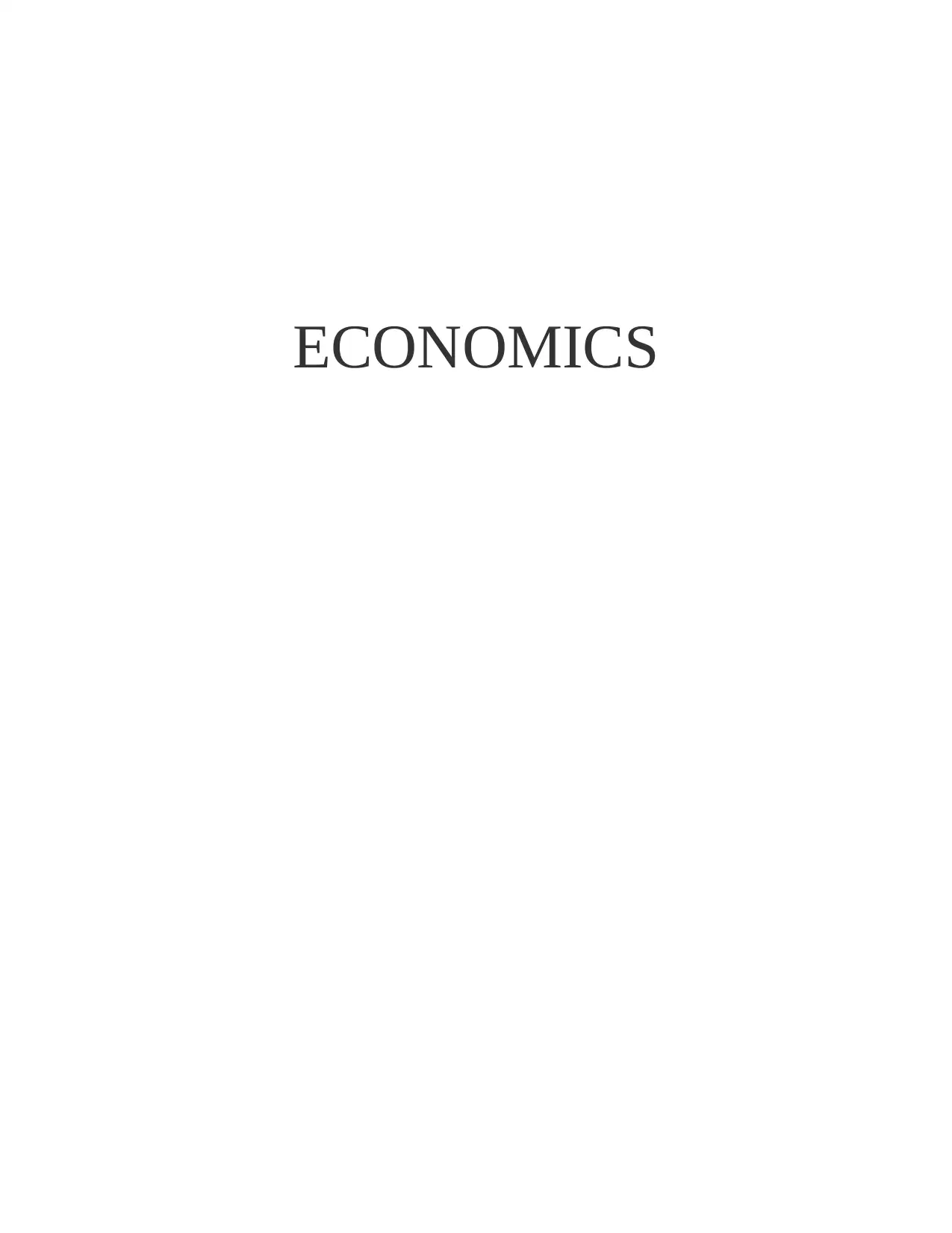
ECONOMICS
Paraphrase This Document
Need a fresh take? Get an instant paraphrase of this document with our AI Paraphraser
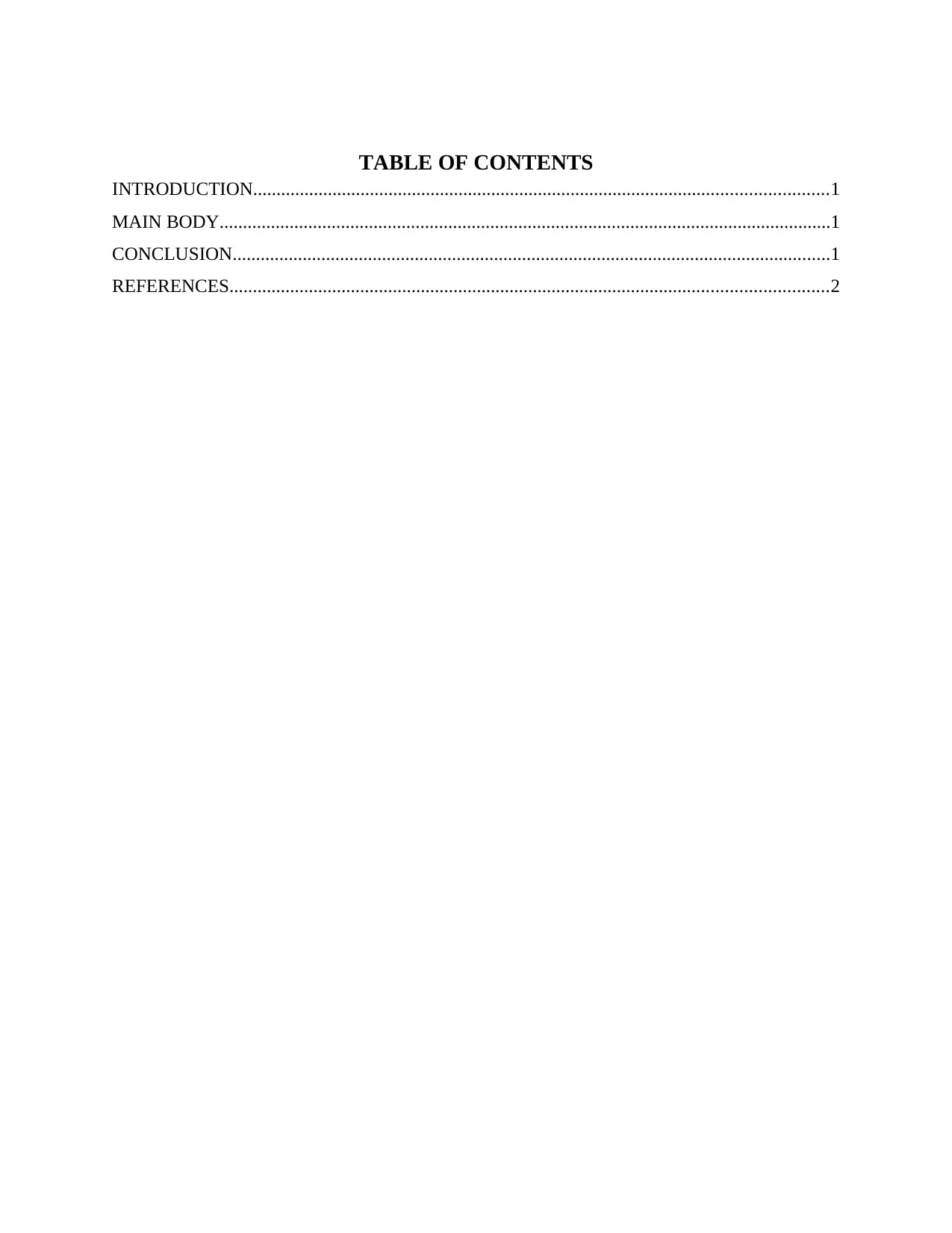
TABLE OF CONTENTS
INTRODUCTION...........................................................................................................................1
MAIN BODY...................................................................................................................................1
CONCLUSION................................................................................................................................1
REFERENCES................................................................................................................................2
INTRODUCTION...........................................................................................................................1
MAIN BODY...................................................................................................................................1
CONCLUSION................................................................................................................................1
REFERENCES................................................................................................................................2
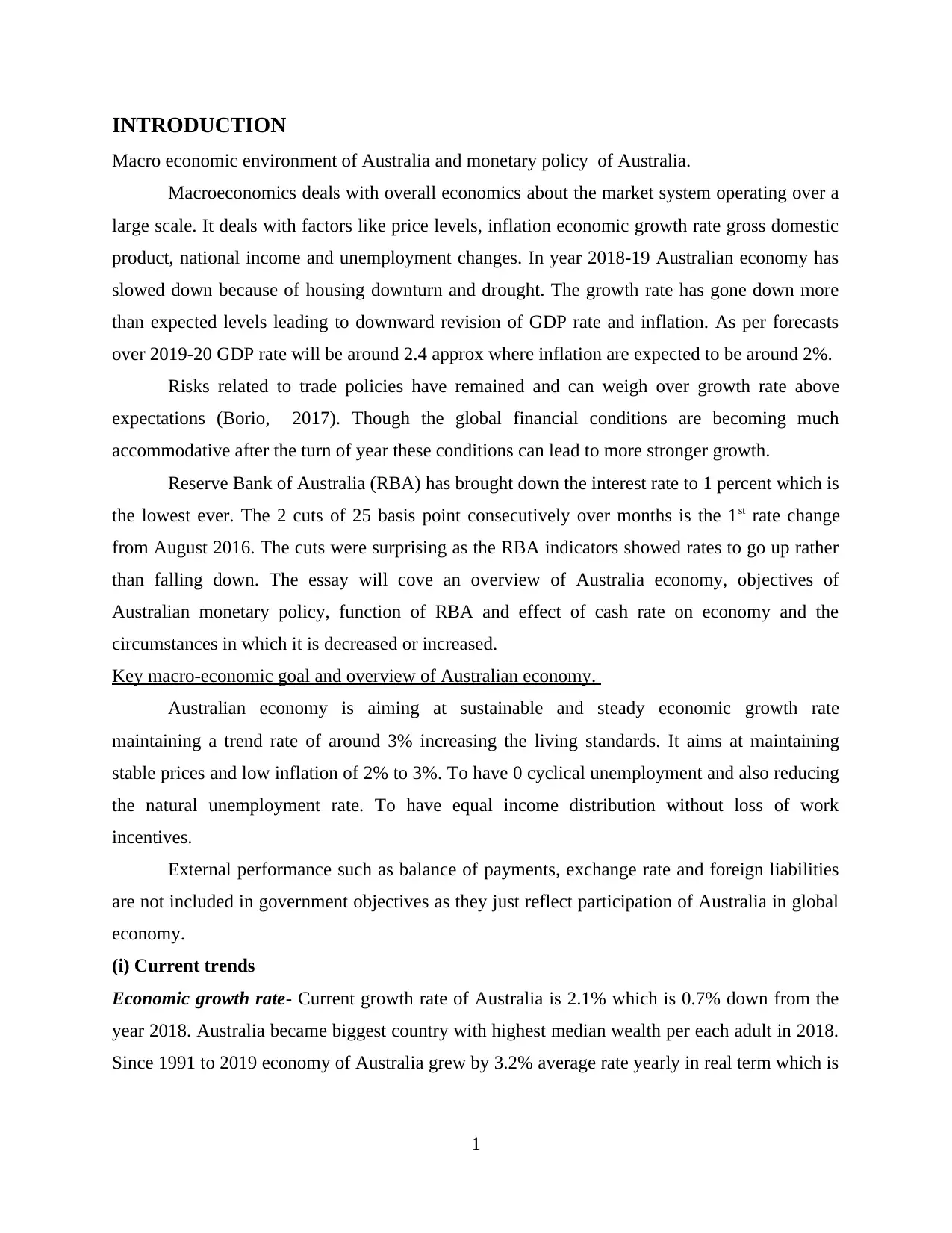
INTRODUCTION
Macro economic environment of Australia and monetary policy of Australia.
Macroeconomics deals with overall economics about the market system operating over a
large scale. It deals with factors like price levels, inflation economic growth rate gross domestic
product, national income and unemployment changes. In year 2018-19 Australian economy has
slowed down because of housing downturn and drought. The growth rate has gone down more
than expected levels leading to downward revision of GDP rate and inflation. As per forecasts
over 2019-20 GDP rate will be around 2.4 approx where inflation are expected to be around 2%.
Risks related to trade policies have remained and can weigh over growth rate above
expectations (Borio, 2017). Though the global financial conditions are becoming much
accommodative after the turn of year these conditions can lead to more stronger growth.
Reserve Bank of Australia (RBA) has brought down the interest rate to 1 percent which is
the lowest ever. The 2 cuts of 25 basis point consecutively over months is the 1st rate change
from August 2016. The cuts were surprising as the RBA indicators showed rates to go up rather
than falling down. The essay will cove an overview of Australia economy, objectives of
Australian monetary policy, function of RBA and effect of cash rate on economy and the
circumstances in which it is decreased or increased.
Key macro-economic goal and overview of Australian economy.
Australian economy is aiming at sustainable and steady economic growth rate
maintaining a trend rate of around 3% increasing the living standards. It aims at maintaining
stable prices and low inflation of 2% to 3%. To have 0 cyclical unemployment and also reducing
the natural unemployment rate. To have equal income distribution without loss of work
incentives.
External performance such as balance of payments, exchange rate and foreign liabilities
are not included in government objectives as they just reflect participation of Australia in global
economy.
(i) Current trends
Economic growth rate- Current growth rate of Australia is 2.1% which is 0.7% down from the
year 2018. Australia became biggest country with highest median wealth per each adult in 2018.
Since 1991 to 2019 economy of Australia grew by 3.2% average rate yearly in real term which is
1
Macro economic environment of Australia and monetary policy of Australia.
Macroeconomics deals with overall economics about the market system operating over a
large scale. It deals with factors like price levels, inflation economic growth rate gross domestic
product, national income and unemployment changes. In year 2018-19 Australian economy has
slowed down because of housing downturn and drought. The growth rate has gone down more
than expected levels leading to downward revision of GDP rate and inflation. As per forecasts
over 2019-20 GDP rate will be around 2.4 approx where inflation are expected to be around 2%.
Risks related to trade policies have remained and can weigh over growth rate above
expectations (Borio, 2017). Though the global financial conditions are becoming much
accommodative after the turn of year these conditions can lead to more stronger growth.
Reserve Bank of Australia (RBA) has brought down the interest rate to 1 percent which is
the lowest ever. The 2 cuts of 25 basis point consecutively over months is the 1st rate change
from August 2016. The cuts were surprising as the RBA indicators showed rates to go up rather
than falling down. The essay will cove an overview of Australia economy, objectives of
Australian monetary policy, function of RBA and effect of cash rate on economy and the
circumstances in which it is decreased or increased.
Key macro-economic goal and overview of Australian economy.
Australian economy is aiming at sustainable and steady economic growth rate
maintaining a trend rate of around 3% increasing the living standards. It aims at maintaining
stable prices and low inflation of 2% to 3%. To have 0 cyclical unemployment and also reducing
the natural unemployment rate. To have equal income distribution without loss of work
incentives.
External performance such as balance of payments, exchange rate and foreign liabilities
are not included in government objectives as they just reflect participation of Australia in global
economy.
(i) Current trends
Economic growth rate- Current growth rate of Australia is 2.1% which is 0.7% down from the
year 2018. Australia became biggest country with highest median wealth per each adult in 2018.
Since 1991 to 2019 economy of Australia grew by 3.2% average rate yearly in real term which is
1
⊘ This is a preview!⊘
Do you want full access?
Subscribe today to unlock all pages.

Trusted by 1+ million students worldwide
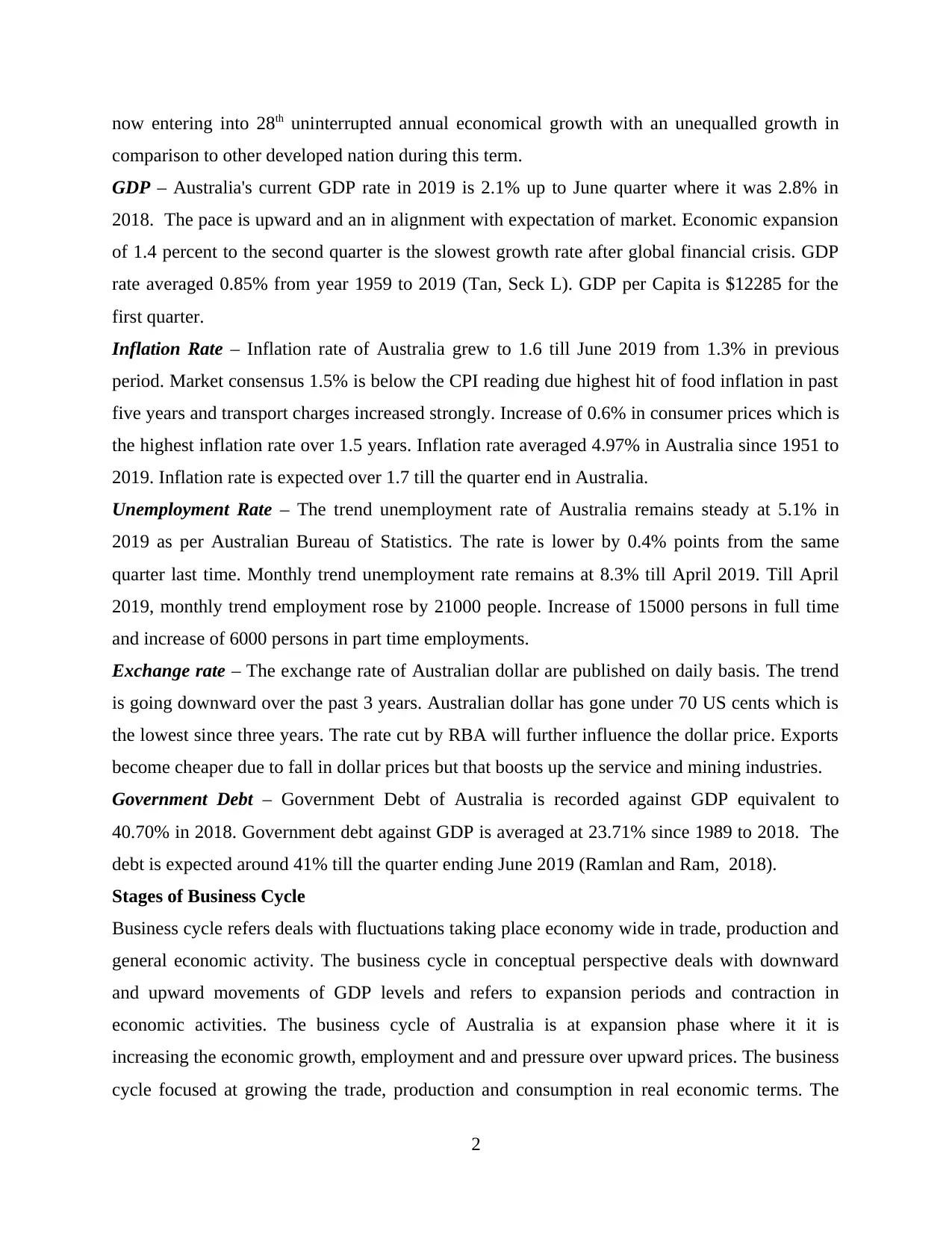
now entering into 28th uninterrupted annual economical growth with an unequalled growth in
comparison to other developed nation during this term.
GDP – Australia's current GDP rate in 2019 is 2.1% up to June quarter where it was 2.8% in
2018. The pace is upward and an in alignment with expectation of market. Economic expansion
of 1.4 percent to the second quarter is the slowest growth rate after global financial crisis. GDP
rate averaged 0.85% from year 1959 to 2019 (Tan, Seck L). GDP per Capita is $12285 for the
first quarter.
Inflation Rate – Inflation rate of Australia grew to 1.6 till June 2019 from 1.3% in previous
period. Market consensus 1.5% is below the CPI reading due highest hit of food inflation in past
five years and transport charges increased strongly. Increase of 0.6% in consumer prices which is
the highest inflation rate over 1.5 years. Inflation rate averaged 4.97% in Australia since 1951 to
2019. Inflation rate is expected over 1.7 till the quarter end in Australia.
Unemployment Rate – The trend unemployment rate of Australia remains steady at 5.1% in
2019 as per Australian Bureau of Statistics. The rate is lower by 0.4% points from the same
quarter last time. Monthly trend unemployment rate remains at 8.3% till April 2019. Till April
2019, monthly trend employment rose by 21000 people. Increase of 15000 persons in full time
and increase of 6000 persons in part time employments.
Exchange rate – The exchange rate of Australian dollar are published on daily basis. The trend
is going downward over the past 3 years. Australian dollar has gone under 70 US cents which is
the lowest since three years. The rate cut by RBA will further influence the dollar price. Exports
become cheaper due to fall in dollar prices but that boosts up the service and mining industries.
Government Debt – Government Debt of Australia is recorded against GDP equivalent to
40.70% in 2018. Government debt against GDP is averaged at 23.71% since 1989 to 2018. The
debt is expected around 41% till the quarter ending June 2019 (Ramlan and Ram, 2018).
Stages of Business Cycle
Business cycle refers deals with fluctuations taking place economy wide in trade, production and
general economic activity. The business cycle in conceptual perspective deals with downward
and upward movements of GDP levels and refers to expansion periods and contraction in
economic activities. The business cycle of Australia is at expansion phase where it it is
increasing the economic growth, employment and and pressure over upward prices. The business
cycle focused at growing the trade, production and consumption in real economic terms. The
2
comparison to other developed nation during this term.
GDP – Australia's current GDP rate in 2019 is 2.1% up to June quarter where it was 2.8% in
2018. The pace is upward and an in alignment with expectation of market. Economic expansion
of 1.4 percent to the second quarter is the slowest growth rate after global financial crisis. GDP
rate averaged 0.85% from year 1959 to 2019 (Tan, Seck L). GDP per Capita is $12285 for the
first quarter.
Inflation Rate – Inflation rate of Australia grew to 1.6 till June 2019 from 1.3% in previous
period. Market consensus 1.5% is below the CPI reading due highest hit of food inflation in past
five years and transport charges increased strongly. Increase of 0.6% in consumer prices which is
the highest inflation rate over 1.5 years. Inflation rate averaged 4.97% in Australia since 1951 to
2019. Inflation rate is expected over 1.7 till the quarter end in Australia.
Unemployment Rate – The trend unemployment rate of Australia remains steady at 5.1% in
2019 as per Australian Bureau of Statistics. The rate is lower by 0.4% points from the same
quarter last time. Monthly trend unemployment rate remains at 8.3% till April 2019. Till April
2019, monthly trend employment rose by 21000 people. Increase of 15000 persons in full time
and increase of 6000 persons in part time employments.
Exchange rate – The exchange rate of Australian dollar are published on daily basis. The trend
is going downward over the past 3 years. Australian dollar has gone under 70 US cents which is
the lowest since three years. The rate cut by RBA will further influence the dollar price. Exports
become cheaper due to fall in dollar prices but that boosts up the service and mining industries.
Government Debt – Government Debt of Australia is recorded against GDP equivalent to
40.70% in 2018. Government debt against GDP is averaged at 23.71% since 1989 to 2018. The
debt is expected around 41% till the quarter ending June 2019 (Ramlan and Ram, 2018).
Stages of Business Cycle
Business cycle refers deals with fluctuations taking place economy wide in trade, production and
general economic activity. The business cycle in conceptual perspective deals with downward
and upward movements of GDP levels and refers to expansion periods and contraction in
economic activities. The business cycle of Australia is at expansion phase where it it is
increasing the economic growth, employment and and pressure over upward prices. The business
cycle focused at growing the trade, production and consumption in real economic terms. The
2
Paraphrase This Document
Need a fresh take? Get an instant paraphrase of this document with our AI Paraphraser
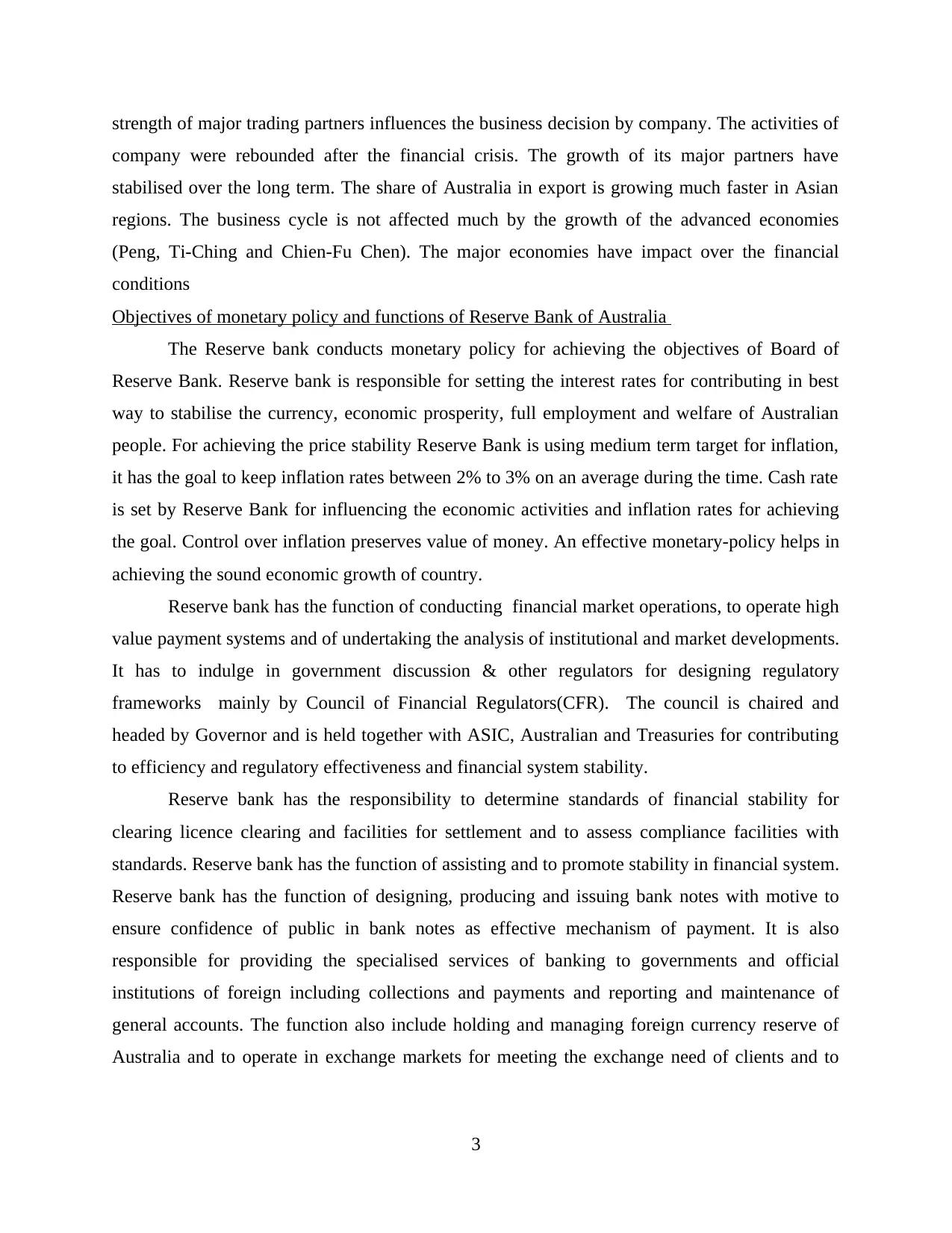
strength of major trading partners influences the business decision by company. The activities of
company were rebounded after the financial crisis. The growth of its major partners have
stabilised over the long term. The share of Australia in export is growing much faster in Asian
regions. The business cycle is not affected much by the growth of the advanced economies
(Peng, Ti-Ching and Chien-Fu Chen). The major economies have impact over the financial
conditions
Objectives of monetary policy and functions of Reserve Bank of Australia
The Reserve bank conducts monetary policy for achieving the objectives of Board of
Reserve Bank. Reserve bank is responsible for setting the interest rates for contributing in best
way to stabilise the currency, economic prosperity, full employment and welfare of Australian
people. For achieving the price stability Reserve Bank is using medium term target for inflation,
it has the goal to keep inflation rates between 2% to 3% on an average during the time. Cash rate
is set by Reserve Bank for influencing the economic activities and inflation rates for achieving
the goal. Control over inflation preserves value of money. An effective monetary-policy helps in
achieving the sound economic growth of country.
Reserve bank has the function of conducting financial market operations, to operate high
value payment systems and of undertaking the analysis of institutional and market developments.
It has to indulge in government discussion & other regulators for designing regulatory
frameworks mainly by Council of Financial Regulators(CFR). The council is chaired and
headed by Governor and is held together with ASIC, Australian and Treasuries for contributing
to efficiency and regulatory effectiveness and financial system stability.
Reserve bank has the responsibility to determine standards of financial stability for
clearing licence clearing and facilities for settlement and to assess compliance facilities with
standards. Reserve bank has the function of assisting and to promote stability in financial system.
Reserve bank has the function of designing, producing and issuing bank notes with motive to
ensure confidence of public in bank notes as effective mechanism of payment. It is also
responsible for providing the specialised services of banking to governments and official
institutions of foreign including collections and payments and reporting and maintenance of
general accounts. The function also include holding and managing foreign currency reserve of
Australia and to operate in exchange markets for meeting the exchange need of clients and to
3
company were rebounded after the financial crisis. The growth of its major partners have
stabilised over the long term. The share of Australia in export is growing much faster in Asian
regions. The business cycle is not affected much by the growth of the advanced economies
(Peng, Ti-Ching and Chien-Fu Chen). The major economies have impact over the financial
conditions
Objectives of monetary policy and functions of Reserve Bank of Australia
The Reserve bank conducts monetary policy for achieving the objectives of Board of
Reserve Bank. Reserve bank is responsible for setting the interest rates for contributing in best
way to stabilise the currency, economic prosperity, full employment and welfare of Australian
people. For achieving the price stability Reserve Bank is using medium term target for inflation,
it has the goal to keep inflation rates between 2% to 3% on an average during the time. Cash rate
is set by Reserve Bank for influencing the economic activities and inflation rates for achieving
the goal. Control over inflation preserves value of money. An effective monetary-policy helps in
achieving the sound economic growth of country.
Reserve bank has the function of conducting financial market operations, to operate high
value payment systems and of undertaking the analysis of institutional and market developments.
It has to indulge in government discussion & other regulators for designing regulatory
frameworks mainly by Council of Financial Regulators(CFR). The council is chaired and
headed by Governor and is held together with ASIC, Australian and Treasuries for contributing
to efficiency and regulatory effectiveness and financial system stability.
Reserve bank has the responsibility to determine standards of financial stability for
clearing licence clearing and facilities for settlement and to assess compliance facilities with
standards. Reserve bank has the function of assisting and to promote stability in financial system.
Reserve bank has the function of designing, producing and issuing bank notes with motive to
ensure confidence of public in bank notes as effective mechanism of payment. It is also
responsible for providing the specialised services of banking to governments and official
institutions of foreign including collections and payments and reporting and maintenance of
general accounts. The function also include holding and managing foreign currency reserve of
Australia and to operate in exchange markets for meeting the exchange need of clients and to
3
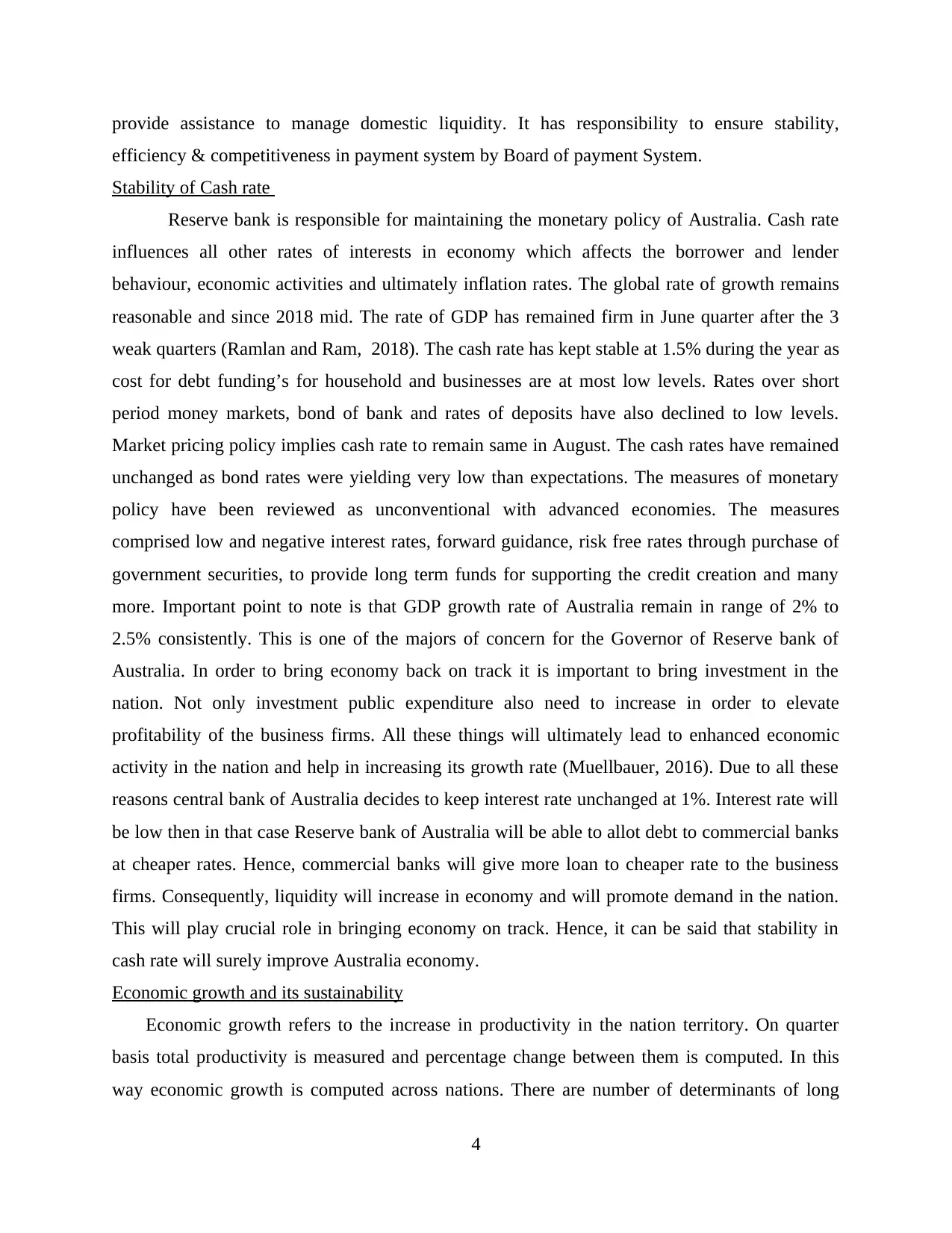
provide assistance to manage domestic liquidity. It has responsibility to ensure stability,
efficiency & competitiveness in payment system by Board of payment System.
Stability of Cash rate
Reserve bank is responsible for maintaining the monetary policy of Australia. Cash rate
influences all other rates of interests in economy which affects the borrower and lender
behaviour, economic activities and ultimately inflation rates. The global rate of growth remains
reasonable and since 2018 mid. The rate of GDP has remained firm in June quarter after the 3
weak quarters (Ramlan and Ram, 2018). The cash rate has kept stable at 1.5% during the year as
cost for debt funding’s for household and businesses are at most low levels. Rates over short
period money markets, bond of bank and rates of deposits have also declined to low levels.
Market pricing policy implies cash rate to remain same in August. The cash rates have remained
unchanged as bond rates were yielding very low than expectations. The measures of monetary
policy have been reviewed as unconventional with advanced economies. The measures
comprised low and negative interest rates, forward guidance, risk free rates through purchase of
government securities, to provide long term funds for supporting the credit creation and many
more. Important point to note is that GDP growth rate of Australia remain in range of 2% to
2.5% consistently. This is one of the majors of concern for the Governor of Reserve bank of
Australia. In order to bring economy back on track it is important to bring investment in the
nation. Not only investment public expenditure also need to increase in order to elevate
profitability of the business firms. All these things will ultimately lead to enhanced economic
activity in the nation and help in increasing its growth rate (Muellbauer, 2016). Due to all these
reasons central bank of Australia decides to keep interest rate unchanged at 1%. Interest rate will
be low then in that case Reserve bank of Australia will be able to allot debt to commercial banks
at cheaper rates. Hence, commercial banks will give more loan to cheaper rate to the business
firms. Consequently, liquidity will increase in economy and will promote demand in the nation.
This will play crucial role in bringing economy on track. Hence, it can be said that stability in
cash rate will surely improve Australia economy.
Economic growth and its sustainability
Economic growth refers to the increase in productivity in the nation territory. On quarter
basis total productivity is measured and percentage change between them is computed. In this
way economic growth is computed across nations. There are number of determinants of long
4
efficiency & competitiveness in payment system by Board of payment System.
Stability of Cash rate
Reserve bank is responsible for maintaining the monetary policy of Australia. Cash rate
influences all other rates of interests in economy which affects the borrower and lender
behaviour, economic activities and ultimately inflation rates. The global rate of growth remains
reasonable and since 2018 mid. The rate of GDP has remained firm in June quarter after the 3
weak quarters (Ramlan and Ram, 2018). The cash rate has kept stable at 1.5% during the year as
cost for debt funding’s for household and businesses are at most low levels. Rates over short
period money markets, bond of bank and rates of deposits have also declined to low levels.
Market pricing policy implies cash rate to remain same in August. The cash rates have remained
unchanged as bond rates were yielding very low than expectations. The measures of monetary
policy have been reviewed as unconventional with advanced economies. The measures
comprised low and negative interest rates, forward guidance, risk free rates through purchase of
government securities, to provide long term funds for supporting the credit creation and many
more. Important point to note is that GDP growth rate of Australia remain in range of 2% to
2.5% consistently. This is one of the majors of concern for the Governor of Reserve bank of
Australia. In order to bring economy back on track it is important to bring investment in the
nation. Not only investment public expenditure also need to increase in order to elevate
profitability of the business firms. All these things will ultimately lead to enhanced economic
activity in the nation and help in increasing its growth rate (Muellbauer, 2016). Due to all these
reasons central bank of Australia decides to keep interest rate unchanged at 1%. Interest rate will
be low then in that case Reserve bank of Australia will be able to allot debt to commercial banks
at cheaper rates. Hence, commercial banks will give more loan to cheaper rate to the business
firms. Consequently, liquidity will increase in economy and will promote demand in the nation.
This will play crucial role in bringing economy on track. Hence, it can be said that stability in
cash rate will surely improve Australia economy.
Economic growth and its sustainability
Economic growth refers to the increase in productivity in the nation territory. On quarter
basis total productivity is measured and percentage change between them is computed. In this
way economic growth is computed across nations. There are number of determinants of long
4
⊘ This is a preview!⊘
Do you want full access?
Subscribe today to unlock all pages.

Trusted by 1+ million students worldwide
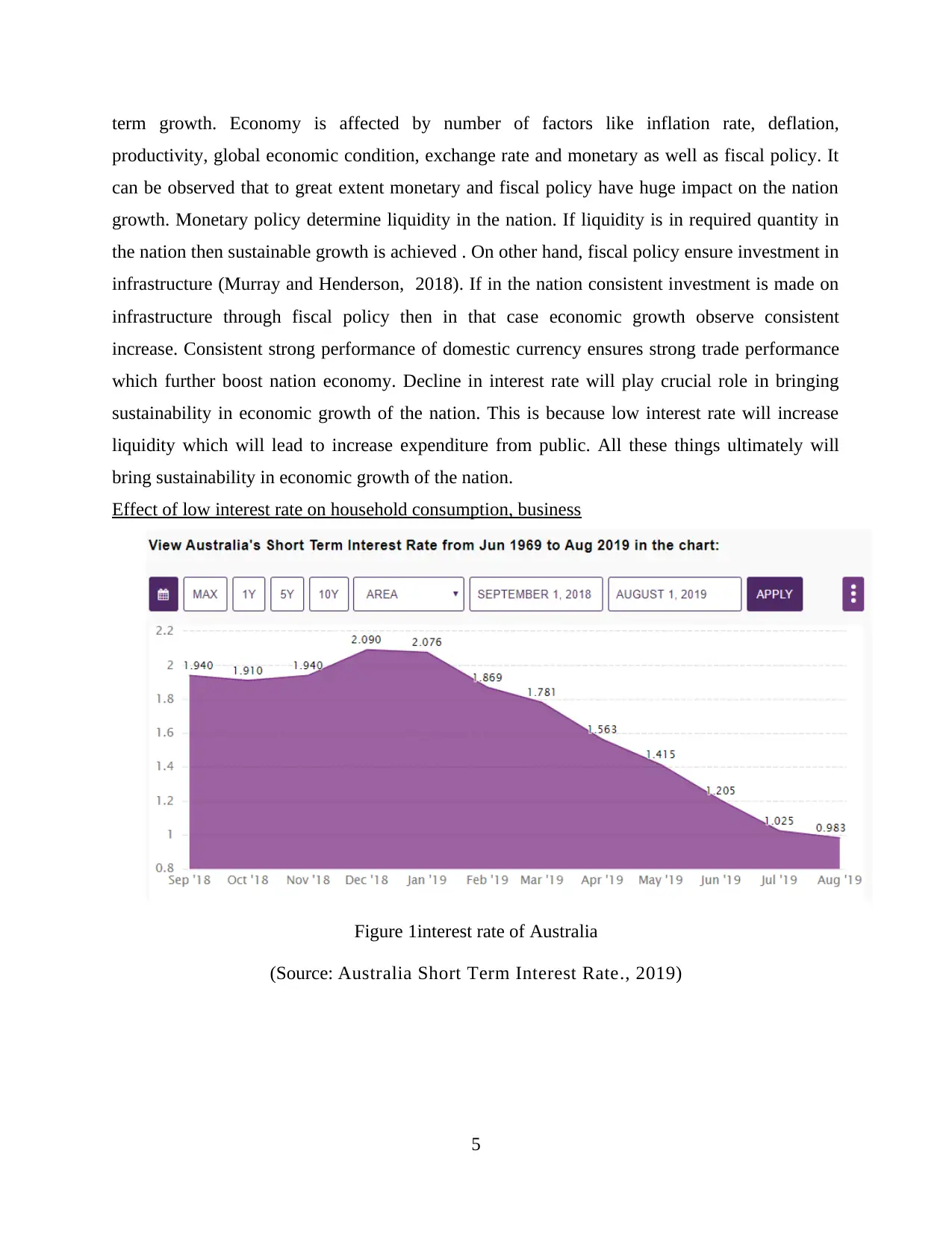
term growth. Economy is affected by number of factors like inflation rate, deflation,
productivity, global economic condition, exchange rate and monetary as well as fiscal policy. It
can be observed that to great extent monetary and fiscal policy have huge impact on the nation
growth. Monetary policy determine liquidity in the nation. If liquidity is in required quantity in
the nation then sustainable growth is achieved . On other hand, fiscal policy ensure investment in
infrastructure (Murray and Henderson, 2018). If in the nation consistent investment is made on
infrastructure through fiscal policy then in that case economic growth observe consistent
increase. Consistent strong performance of domestic currency ensures strong trade performance
which further boost nation economy. Decline in interest rate will play crucial role in bringing
sustainability in economic growth of the nation. This is because low interest rate will increase
liquidity which will lead to increase expenditure from public. All these things ultimately will
bring sustainability in economic growth of the nation.
Effect of low interest rate on household consumption, business
Figure 1interest rate of Australia
(Source: Australia Short Term Interest Rate., 2019)
5
productivity, global economic condition, exchange rate and monetary as well as fiscal policy. It
can be observed that to great extent monetary and fiscal policy have huge impact on the nation
growth. Monetary policy determine liquidity in the nation. If liquidity is in required quantity in
the nation then sustainable growth is achieved . On other hand, fiscal policy ensure investment in
infrastructure (Murray and Henderson, 2018). If in the nation consistent investment is made on
infrastructure through fiscal policy then in that case economic growth observe consistent
increase. Consistent strong performance of domestic currency ensures strong trade performance
which further boost nation economy. Decline in interest rate will play crucial role in bringing
sustainability in economic growth of the nation. This is because low interest rate will increase
liquidity which will lead to increase expenditure from public. All these things ultimately will
bring sustainability in economic growth of the nation.
Effect of low interest rate on household consumption, business
Figure 1interest rate of Australia
(Source: Australia Short Term Interest Rate., 2019)
5
Paraphrase This Document
Need a fresh take? Get an instant paraphrase of this document with our AI Paraphraser
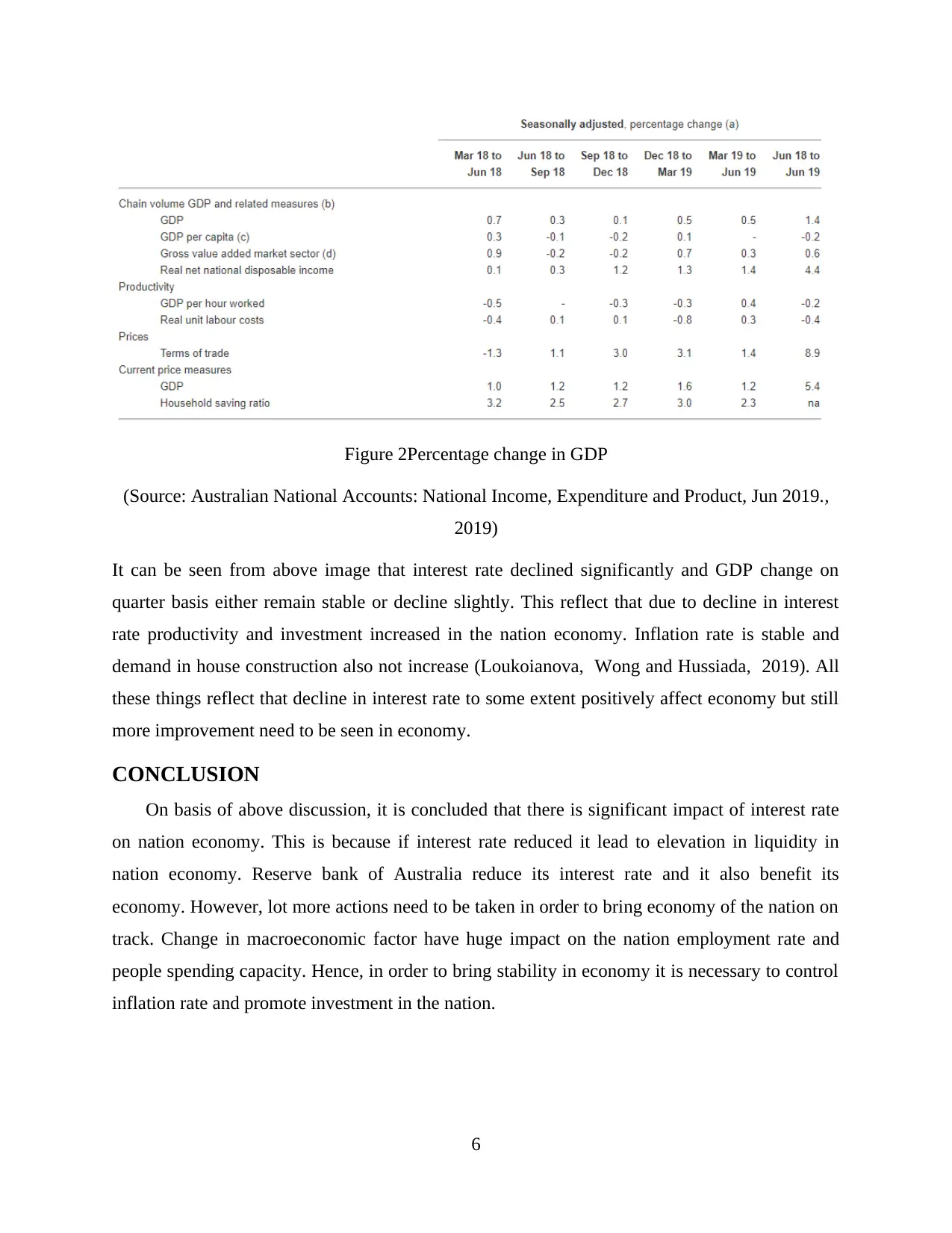
Figure 2Percentage change in GDP
(Source: Australian National Accounts: National Income, Expenditure and Product, Jun 2019.,
2019)
It can be seen from above image that interest rate declined significantly and GDP change on
quarter basis either remain stable or decline slightly. This reflect that due to decline in interest
rate productivity and investment increased in the nation economy. Inflation rate is stable and
demand in house construction also not increase (Loukoianova, Wong and Hussiada, 2019). All
these things reflect that decline in interest rate to some extent positively affect economy but still
more improvement need to be seen in economy.
CONCLUSION
On basis of above discussion, it is concluded that there is significant impact of interest rate
on nation economy. This is because if interest rate reduced it lead to elevation in liquidity in
nation economy. Reserve bank of Australia reduce its interest rate and it also benefit its
economy. However, lot more actions need to be taken in order to bring economy of the nation on
track. Change in macroeconomic factor have huge impact on the nation employment rate and
people spending capacity. Hence, in order to bring stability in economy it is necessary to control
inflation rate and promote investment in the nation.
6
(Source: Australian National Accounts: National Income, Expenditure and Product, Jun 2019.,
2019)
It can be seen from above image that interest rate declined significantly and GDP change on
quarter basis either remain stable or decline slightly. This reflect that due to decline in interest
rate productivity and investment increased in the nation economy. Inflation rate is stable and
demand in house construction also not increase (Loukoianova, Wong and Hussiada, 2019). All
these things reflect that decline in interest rate to some extent positively affect economy but still
more improvement need to be seen in economy.
CONCLUSION
On basis of above discussion, it is concluded that there is significant impact of interest rate
on nation economy. This is because if interest rate reduced it lead to elevation in liquidity in
nation economy. Reserve bank of Australia reduce its interest rate and it also benefit its
economy. However, lot more actions need to be taken in order to bring economy of the nation on
track. Change in macroeconomic factor have huge impact on the nation employment rate and
people spending capacity. Hence, in order to bring stability in economy it is necessary to control
inflation rate and promote investment in the nation.
6

REFERENCES
Books and Journals
Borio, C., 2017. Macroeconomics and the financial cycle: Hamlet without the Prince?.
EXECUTIVE BOARD. p.73.
Loukoianova, M.E., Wong, Y.C. and Hussiada, I., 2019. Household Debt, Consumption, and
Monetary Policy in Australia. International Monetary Fund.
Muellbauer, J., 2016. Macroeconomics and consumption.
Murray, C. and Henderson, T., 2018. The Consequences of Fiscal Austerity in Western
Australia.
Peng, Ti-Ching, and Chien-Fu Chen. "The effect of quality determinants on house prices of eight
capital cities in Australia: A dynamic panel analysis." International Journal of Housing
Markets and Analysis 9, no. 3 (2016): 355-375.
Ramlan, H. and Ram, N.S., 2018. Determinants of Macroeconomics Indicators on the Economic
Growth in Malaysia. Global Business & Management Research. 10.
Tan, Seck L. "Potential environmental impacts of the Australia–South Korea Free Trade
Agreement and fiscal intervention." In Green Fiscal Reform for a Sustainable Future.
Edward Elgar Publishing, 2016.
Online
Australia Short Term Interest Rate., 2019. [Online]. Available through:<
https://www.ceicdata.com/en/indicator/australia/short-term-interest-rate>.
Australian National Accounts: National Income, Expenditure and Product, Jun 2019., 2019.
Available through:< https://www.abs.gov.au/ausstats/abs@.nsf/mf/5206.0>.
7
Books and Journals
Borio, C., 2017. Macroeconomics and the financial cycle: Hamlet without the Prince?.
EXECUTIVE BOARD. p.73.
Loukoianova, M.E., Wong, Y.C. and Hussiada, I., 2019. Household Debt, Consumption, and
Monetary Policy in Australia. International Monetary Fund.
Muellbauer, J., 2016. Macroeconomics and consumption.
Murray, C. and Henderson, T., 2018. The Consequences of Fiscal Austerity in Western
Australia.
Peng, Ti-Ching, and Chien-Fu Chen. "The effect of quality determinants on house prices of eight
capital cities in Australia: A dynamic panel analysis." International Journal of Housing
Markets and Analysis 9, no. 3 (2016): 355-375.
Ramlan, H. and Ram, N.S., 2018. Determinants of Macroeconomics Indicators on the Economic
Growth in Malaysia. Global Business & Management Research. 10.
Tan, Seck L. "Potential environmental impacts of the Australia–South Korea Free Trade
Agreement and fiscal intervention." In Green Fiscal Reform for a Sustainable Future.
Edward Elgar Publishing, 2016.
Online
Australia Short Term Interest Rate., 2019. [Online]. Available through:<
https://www.ceicdata.com/en/indicator/australia/short-term-interest-rate>.
Australian National Accounts: National Income, Expenditure and Product, Jun 2019., 2019.
Available through:< https://www.abs.gov.au/ausstats/abs@.nsf/mf/5206.0>.
7
⊘ This is a preview!⊘
Do you want full access?
Subscribe today to unlock all pages.

Trusted by 1+ million students worldwide
1 out of 9
Related Documents
Your All-in-One AI-Powered Toolkit for Academic Success.
+13062052269
info@desklib.com
Available 24*7 on WhatsApp / Email
![[object Object]](/_next/static/media/star-bottom.7253800d.svg)
Unlock your academic potential
Copyright © 2020–2025 A2Z Services. All Rights Reserved. Developed and managed by ZUCOL.





